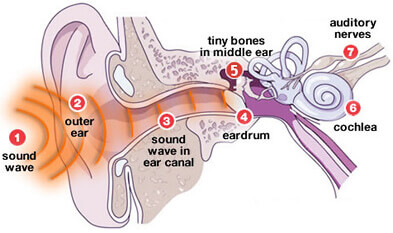Human Ear Structure and Function
The Structure of Ear comprised of the following three main parts. How the Ear Works described below:
Parts of the Ear
- External Ear or Outer Ear specialized for receiving the sound waves which comprised of following parts that are Auricle or Pinna and External Auditory Meatus.
- Middle Ear comprised of Tympanic Membranes and Auditory Ossicles.
- Inner Ear consists of Vestibules, Semicircular Canal and Cochlea.
- The three Semicircular Canals in the ear are not concerned with hearing. Instead, they help us to balance.
How the Ear Works Step by Step?

How the Ear Works?
The part of the ear we see is called the outer ear. Most of the ear is inside the bones of the skull, were protected from damage. Because the outer ear is funnel-shaped, it can collect sound waves Coming from moving objects. It focuses them on the eardrum inside the head.
The eardrum then Vibrates, making a group of three tiny bones (called ossicles) that are attached to it vibrate as well. The three ossicles act as a lever and magnify the force of the vibrations moving the liquid inside the snail-shaped. the inner ear, or Cochlea.
The vibrations inside the cochlea make tiny hairs move. As these hairs are attached to nerves, every time they are vibrated, messages are sent to the brain. These nerve messages enable us to hear and understand sounds, including speech.
The ear and brain working together can separate sounds depending on how loud they are or how: high or low. Having two ears, one on each side of the head helps us to tell the direction the sound is coming from, as it will be slightly louder in one ear than the other unless the sound is Straight ahead or immediately behind us.
Semicircular Canals are set at right angles to each other, so that no matter how the head is moved—up, down, left, or right—the fluid in the canals will also move.
The pressure of this fluid stimulates the sensitive hairs “within the canals to send messages to the brain. If you spin rapidly and then stop, the fluid will carry on moving, making you feel giddy. You can stop this by suddenly jerking your head in the opposite direction.
Two sacs join the cochlea to the semicircular canals and act as gravity detectors. They contain grains of chalk which move about as we tilt and trigger sensitive hairs.
Continuous up-and-down movement over-stimulates the brain and this causes what is called Seasickness.



